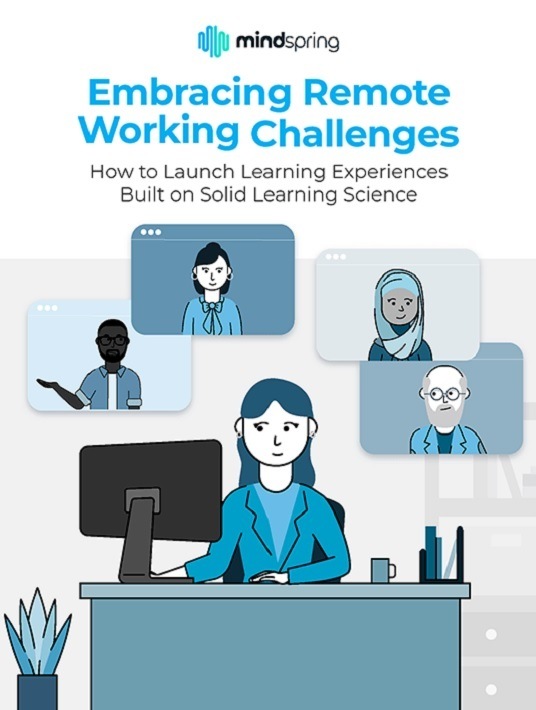Communication Is Key: The Essentials Of Language In Learning
This article is part of a series on overcoming remote working challenges by building learning experiences that are based on solid learning science. What you are about to read is a fable. The company, AshCom, is fictional, but the learning challenges faced by Kathryn, AshCom’s CLO, and her team are real and commonly shared by learning teams in large organizations. It is our hope that you will be able to connect with the characters, their challenges, and the solutions they discover. We also invite you to read the first eBook in the series.

The Queen Of Games
Adeena was known around the AshCom learning team as the “queen of games.” There were two reasons for this. Adeena loved games of every sort. She was raised playing board games and her family played every chance they got—“Scrabble,” “Settlers of Catan,” “Risk.” Later, she started playing video games, especially those that emphasized the need for strategic thinking. Without telling anyone, she signed up for a tournament for people who liked to play Minecraft.
None of her colleagues at AshCom had a clue about this gaming side of Adeena. Several had worked with her for a while and had no idea. Her passion for games only became known when the AshCom learning team decided to create a true game with the objective of enhancing the financial literacy of its managers.
Adeena was assigned to the true game project by Kathryn, the CLO of AshCom. The only hint Kathryn had about Adeena’s interest came from her resume. Kathryn noticed that Adeena had taken several courses in her undergrad program on game design. Only later did Kathryn learn the extent of Adeena’s expertise.
Something else in Adeena’s resume caught Kathryn’s attention when she was first hired. Adeena was bilingual. She was fluent in Arabic, something she learned from her immigrant parents.
When Kathryn was creating the list of sciences she wanted her learning team to explore as they thought through virtual learning, linguistics was one of the essentials. Kathryn assigned the topic to Adeena hoping her bilingualism might give her particular insights into linguistics.
Kathryn began the lunch-and-learn session on linguistics with a short review of what had been considered so far. Darryl had led a discussion on brain science and virtual learning. Martina followed with a presentation on psychology with some recommendations that would help inform the learning team as they built experiences for remote workers. Michael went next and led the team in a conversation around sociological factors to consider in virtual learning.
With that, Kathryn turned the session over to Adeena. This was not Adeena’s sweet spot. Her preference would have been to work quietly at her desk. Her colleagues were aware of this and did their best with their facial expressions to make her comfortable.
Adeena cleared her throat and began with a note of clarity. “I did my assignment as instructed,” she said, “but that led me to some other topics we need to talk about that were not on Kathryn’s list. We will be talking about more than linguistics.”
No one was surprised given Adeena’s naturally inquisitive mind.
“My presentation will come in two parts. First, linguistics. Second, we will talk about what I think we need to add to the conversation. Using the best of the psychology of learning, I will give you something to think about until we get to the second topic. Think of it as a game. These are your first clues.”
Adeena paused while those around the table leaned in. She went to the whiteboard and wrote, “After his hair went white, he went to school.” After a second or two, she wrote, “Stretch your legs as far as your blanket extends.”
Everyone at the table seemed confused— with the exception of Michael, who smiled like someone who knew the punch line before the teller was finished with the story.
The Science Of Language
“No need for anyone to comment on these now,” said Adeena. “We will come back to them later. Let’s begin with linguistics, or the science of language. Another way to put it is that linguistics is the study of the form, nature, and function of language. It touches on a lot of what we’ve already covered like human cognition, psychology, sociology, and consumer science. Some common questions are: How is language stored in the brain? How does the use of language change behavior?”
Adeena continued, “We shouldn’t think of this at the theoretical level only. It is very practical. You almost certainly adjust what you say and how you say it depending on your audience. You speak differently at work than you do at home. You write differently depending on whether you are sending a text to an old college friend or you are writing an essay for an assignment from Kathryn.”
“I certainly hope so,” said Kathryn.
“I don’t have any old college friends,” said Alishia, the youngest member of the team and a recent college graduate.
“So, you concede the point?” asked Adeena. Everyone nodded.
“Let’s break down some of the components of linguistics,” continued Adeena. She walked to the whiteboard and wrote “Phonetics, Morphology, Semantics, Syntax.”
“Phonetics has to do with how words sound. Morphology focuses on individual words and how they are related to other words. Semantics is simply the study of the meaning of words. And syntax studies the order of words in a sentence or phrase.”
After a pause, she continued, “We are not going to do a deep dive into each of these words, but we need to be aware that all of them have a direct bearing on how we communicate. More specifically, they have a lot to do with what we write and how we design learning experiences. I suppose that much of this is unconscious. We don’t even think about it because we’ve done it for so long, but it would make sense for us to think hard about what we are writing and what we are creating for virtual learning.”
Kathryn jumped in. “This is why I wanted us to go back and think through everything we do before we commit to a completely virtual learning program for remote workers. This is an excellent point. We need to think through the basics, especially how we will use language.”
“For sure,” said Adeena. “It was a good reminder for me too. There are more practical matters for us to consider. A completely virtual learning environment limits what linguists call Discourse Analysis. It means what we do in-person conversations. I’m aware that I am giving off all sorts of signals to you right now. And you are giving me signals in return. There are interruptions in this conversation. There is my intonation and yours when you make a comment. There are pauses. All of them are very normal and, again, unconscious to us. We notice them and usually follow the rules for conversation without even thinking of them. Virtual changes that.”
Michael laughed. “I still haven’t gotten the hang of the cadence of a conversation on a multi-person virtual call. It seems like I’m always interrupting someone. Or they are interrupting me. Sometimes someone says something that might seem offensive to me in a virtual environment but might not be if we were talking to each other directly.”
“That’s right,” said Adeena. “It isn’t that we can’t overcome these challenges. But we need to be aware of them more than before.”
Focusing On Reading Levels
“A few more practical things,” she continued. “The average person in our country reads at a middle school level. For instance, most medical language for the masses is written at a sixth-grade reading level. In a conversation, we might notice that someone was not grasping what we were saying. That would give us the opportunity to clarify. We won’t have that chance in an all-virtual environment. We need to know our learners as we always do. But we also need to focus on their reading levels. It may mean we have to do some comprehension testing before we release a learning experience broadly.”
“What about people for whom English isn’t their first language?” asked Kathryn.
“That’s where we are heading next,” responded Adeena. “Our city, Minneapolis, is an incredibly diverse place. Most of our other manufacturing plants also have diverse cultures and languages. Many of our remote learners will speak other languages. Some of them, like me, learned another language before they learned English.”
Some in the room seemed surprised. Adeena has a standard Minnesota accent like several of her colleagues.
“I was raised speaking Arabic,” she said, clearly aware of the facial expressions of some around the table. “I learned to speak and write English later in my childhood. I have lived in the US for a long time, but there are still expressions that don’t make sense to me. It gets worse when we try to translate them.”
Adeena continued, “The English language is loaded with cliches, jargon, slang, and euphemisms. But so are other languages. It is confusing when someone says something that makes sense to everyone in the room but not to you because you don’t know that expression.”
“Michael, I don’t want to pick on you, but when I wrote those two expressions on the whiteboard, everyone seemed confused. You were the only one smiling.”
She walked over to the whiteboard and pointed to the first expression written there: “After his hair turned white, he went to school.”
“You seem to know what that means,” said Adeena. “Does anyone else know?” No one did.
“Ok, Michael,” said Adeena. “What does that mean, and how did you know?”
“You assume he knows the right answer, but maybe he doesn’t,” said Alishia.
“I know what it means,” said Michael. “It means something like ‘you can’t teach an old dog new tricks.’”
“That’s correct,” said Adeena. “How did you know that?”
Teaching An Old Dog New Tricks
Michael responded, “When I used to teach at the university, I had a younger colleague who became a friend. He was trying to teach me to play golf. He was not successful but once when he was giving me a lesson, he used that expression. I thought he was teasing me because I was quite a bit older than him and my hair is white, what’s left of it anyway. But that wasn’t what he meant. He told me it was an expression his parents used to say that you can’t teach an old dog new tricks.”
“And where was he from?” asked Adeena.
“Saudi Arabia,” said Michael.
“My parents use the expression,” said Adeena. “It’s a fairly common expression in the Middle East, but it makes no sense to most of the rest of the world.”
“How about the other one?” said Kathryn.
“Let’s see if Michael knows that one,” said Adeena. Michael shook his head.
Adeena said, “My parents said this to me many times. Stretch your legs as far as your blanket extends. They said it to me while I was going to school and didn’t have much money. It means ‘live within your means.’”
“Ah,” said Kathryn. “I was getting close to that as I sat here thinking about it. Limited resources, so be careful how far you stretch.”
“Yes,” replied Adeena. “I only use these examples to give you a sense of what it feels like when someone uses idioms. The same applied to technical jargon or slang or euphemism. The point is we really need to be careful with our language in a virtual setting where someone doesn’t have a lot of other feedback to help them understand the meeting. And it might not be easy to ask someone.”
“So how do we address this?” asked Kathryn.
“It will begin with us and our own use of language,” said Adeena. “We will need to be on the constant lookout for this type of language usage. For jargon, it might be helpful to create a guide that has some definitions in it that can be easily accessed. This will be especially true in onboarding.”
“Our time is up,” said Kathryn. “I will tell you that when I assigned this to you, I knew that you were fluent in Arabic. I did not realize that English is actually your second language. This is incredibly helpful. I also thought that this topic might not be as weighty or deep as cognitive science or some of the other sciences, but I was wrong.”
“We can have great things to teach,” said Michael, “but if we don’t focus on how we communicate them, our efforts won’t be effective.”
“Well said,” said Kathryn. “I have an idea. How about we make some cards with these two expressions on them and we put them in our cubicles as a constant reminder to pay careful attention to linguistics?”
“I love it,” said Adeena, thrilled that her exercise hit a nerve. “Thanks to you all for giving me your attention. I learned a lot preparing for this and hope it was helpful to you.”
“Certainly was,” said Kathryn. She wished everyone a good afternoon as they cleaned up the room and went back to work.
Conclusion
Download the eBook Embracing Remote Working Challenges: How To Launch Learning Experiences Built On Solid Learning Science to discover how you can overcome obstacles with targeted solutions backed by learning psychology and proven methodologies. You can also join the webinar to discover which scientific principles are relevant for remote workforce training.










